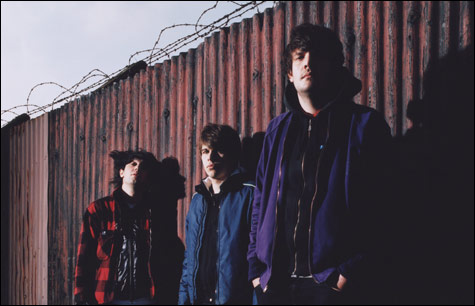
FUTURE HEADS: The band’s influences split the difference between ’80s raves and J.G. Ballard. |
The newest act to come buzzing from the UK is a trio of educated lads whose intelligently obtuse pop is warming hearts, minds, and dance floors. In less than nine months, Klaxons went from pressing 500 handmade seven-inch singles to hitting the #2 spot on the British charts with their debut full length, Myths of the Near Future (Geffen). Their first US tour finds them at Great Scott April 11 with the equally buzzed-about Brazilian baile-funk stars Bonde do Role.
Plenty of Britpop acts have set their sights on the American market, but Klaxons are far from typical. For starters, their lyrics deal with magic, monsters, and mayhem — not rockstardom or the grind of everyday life in Britain. And the distinct sound of Myths of the Near Future, with its avant-garde edge and otherworldly lyrics, has propelled them to the forefront of what’s been dubbed the “new-rave” movement, a reference to both their dancable, technofied rock sound and to certain new-wave sonic touches.
“The whole idea that this thing is being talked about in the American press is sort of baffling to us,” says main Klaxon Jamie Reynolds over the phone from his London home. “Before the band even existed, we wanted to create a media spin for our own amusement, but it’s sort of traveled beyond what we thought we could do with it.”
Indeed, new rave (or, ahem, nü-rave or neu-rave) is a kind of insta-trend that seems to have multiple definitions and sources. But all paths lead back to Klaxons, who invented the phrase with the release of their first single, the wild and wicked “Gravity’s Rainbow.” Fans of the band have embraced the concept — much like devotees of the original British rave scene — by bringing glowsticks and wearing bright colors to Klaxons gigs. “It’s definitely found an audience of people who appreciate the music enough to go out and celebrate it,” says the handsome Reynolds, who’s been described as a “menacing Pied Piper” by the Brit press. “It’s just funny to create a genre that didn’t exist and then tie it to your band.”
Reynolds actually never went to any of the original raves that caused such a stir in England beginning in the late ’80s. And he says he has no intention of trying to bring back the style, the sound, or even the sense of a unified movement that characterized those events. But he does say that it’s something of a “wish fulfillment” to get a taste of something he’d had “no first-hand experience of.” That would account in part for Klaxons’ bare-bones approach to performance. Instead of the wild visuals and light shows that were such a big part of the original raves, Klaxons prefer a more bare-fisted pummeling approach. “It’s basically sort of a hardcore act at the moment. It’s about getting up there and cracking it and doing it.”